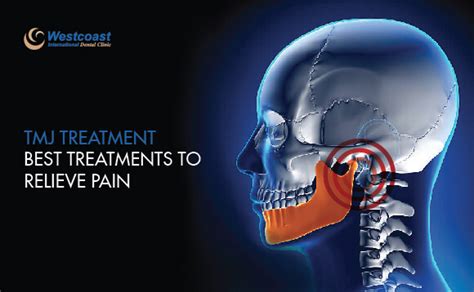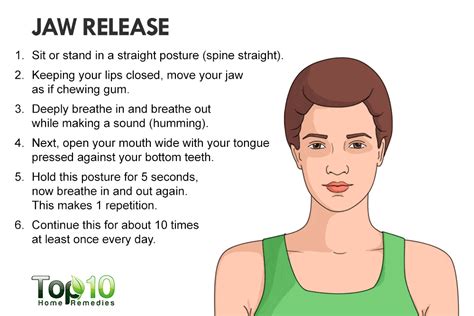Intro
Find relief from TMJ syndrome with simple exercises that ease jaw pain and tension. Learn how to alleviate clicking, locking, and discomfort with gentle stretches and movements that target the temporomandibular joint. Discover the best TMJ exercises, self-care tips, and expert advice for a pain-free jaw and improved overall well-being.
Temporomandibular joint (TMJ) syndrome is a common condition that affects millions of people worldwide. It is characterized by pain and stiffness in the jaw, face, and head, which can be caused by a variety of factors, including teeth grinding, poor posture, and stress. If left untreated, TMJ syndrome can lead to chronic pain, headaches, and even affect a person's overall quality of life.
Fortunately, there are several simple exercises that can help alleviate TMJ syndrome symptoms and provide relief from pain. In this article, we will explore the causes of TMJ syndrome, its symptoms, and most importantly, provide a comprehensive guide to exercises that can help you achieve a pain-free jaw.

Understanding TMJ Syndrome
Before we dive into the exercises, it's essential to understand what causes TMJ syndrome and its symptoms. The temporomandibular joint is a complex joint that connects the jawbone to the skull. It is responsible for facilitating jaw movements, such as talking, chewing, and yawning.
TMJ syndrome occurs when the joint becomes inflamed or irritated, leading to pain and stiffness in the jaw, face, and head. The symptoms of TMJ syndrome can vary from person to person but may include:
- Pain or tenderness in the jaw, face, or temples
- Clicking or popping sounds when opening or closing the mouth
- Difficulty opening or closing the mouth
- Headaches or earaches
- Teeth grinding or clenching
Causes of TMJ Syndrome
There are several causes of TMJ syndrome, including:
- Teeth grinding or clenching
- Poor posture
- Stress and anxiety
- Jaw injury or trauma
- Arthritis or other inflammatory conditions
- Misaligned teeth or bite
Simple Exercises for TMJ Syndrome Relief
Fortunately, there are several simple exercises that can help alleviate TMJ syndrome symptoms and provide relief from pain. Here are some of the most effective exercises:
1. Jaw Release Exercise
This exercise helps to release tension in the jaw and can be done anywhere.
- Sit comfortably with your back straight
- Place your fingers on the top of your teeth, and your thumbs on the bottom of your teeth
- Gently pull your jaw down and forward, feeling the stretch in your jaw
- Hold for 10 seconds and release
- Repeat 10-15 times

2. Masseter Muscle Exercise
The masseter muscle is one of the main muscles responsible for jaw movement. This exercise helps to relax the masseter muscle and can be done anywhere.
- Sit comfortably with your back straight
- Place your fingers on the masseter muscle (located in the cheek, just in front of the ear)
- Gently press the muscle with your fingers, feeling the tension release
- Hold for 10 seconds and release
- Repeat 10-15 times
3. Temporalis Muscle Exercise
The temporalis muscle is another muscle responsible for jaw movement. This exercise helps to relax the temporalis muscle and can be done anywhere.
- Sit comfortably with your back straight
- Place your fingers on the temporalis muscle (located in the temple area)
- Gently press the muscle with your fingers, feeling the tension release
- Hold for 10 seconds and release
- Repeat 10-15 times
4. Chin Tucks
This exercise helps to stretch the muscles in the neck and can help alleviate TMJ syndrome symptoms.
- Stand or sit with your back straight
- Look straight ahead and tuck your chin in towards your chest
- Hold for 10 seconds and release
- Repeat 10-15 times

5. Shoulder Rolls
This exercise helps to relax the muscles in the shoulders and can help alleviate TMJ syndrome symptoms.
- Stand or sit with your back straight
- Roll your shoulders forward and backward in a circular motion
- Repeat 10-15 times
Additional Tips for TMJ Syndrome Relief
In addition to these exercises, there are several other tips that can help alleviate TMJ syndrome symptoms:
- Avoid chewing gum or hard foods
- Avoid teeth grinding or clenching
- Practice good posture
- Manage stress and anxiety through relaxation techniques, such as meditation or deep breathing
- Avoid sleeping on your stomach, as this can cause your jaw to be misaligned

Conclusion
TMJ syndrome is a common condition that can cause pain and stiffness in the jaw, face, and head. Fortunately, there are several simple exercises that can help alleviate symptoms and provide relief from pain. By incorporating these exercises into your daily routine and following the additional tips, you can achieve a pain-free jaw and improve your overall quality of life.
We encourage you to try these exercises and share your experiences with us. If you have any questions or concerns, please don't hesitate to comment below. Don't forget to share this article with your friends and family who may be suffering from TMJ syndrome.
What is TMJ syndrome?
+TMJ syndrome is a condition that affects the temporomandibular joint, causing pain and stiffness in the jaw, face, and head.
What are the symptoms of TMJ syndrome?
+The symptoms of TMJ syndrome include pain or tenderness in the jaw, face, or temples, clicking or popping sounds when opening or closing the mouth, difficulty opening or closing the mouth, headaches or earaches, and teeth grinding or clenching.
How can I alleviate TMJ syndrome symptoms?
+There are several ways to alleviate TMJ syndrome symptoms, including exercises, avoiding chewing gum or hard foods, avoiding teeth grinding or clenching, practicing good posture, managing stress and anxiety, and avoiding sleeping on your stomach.
